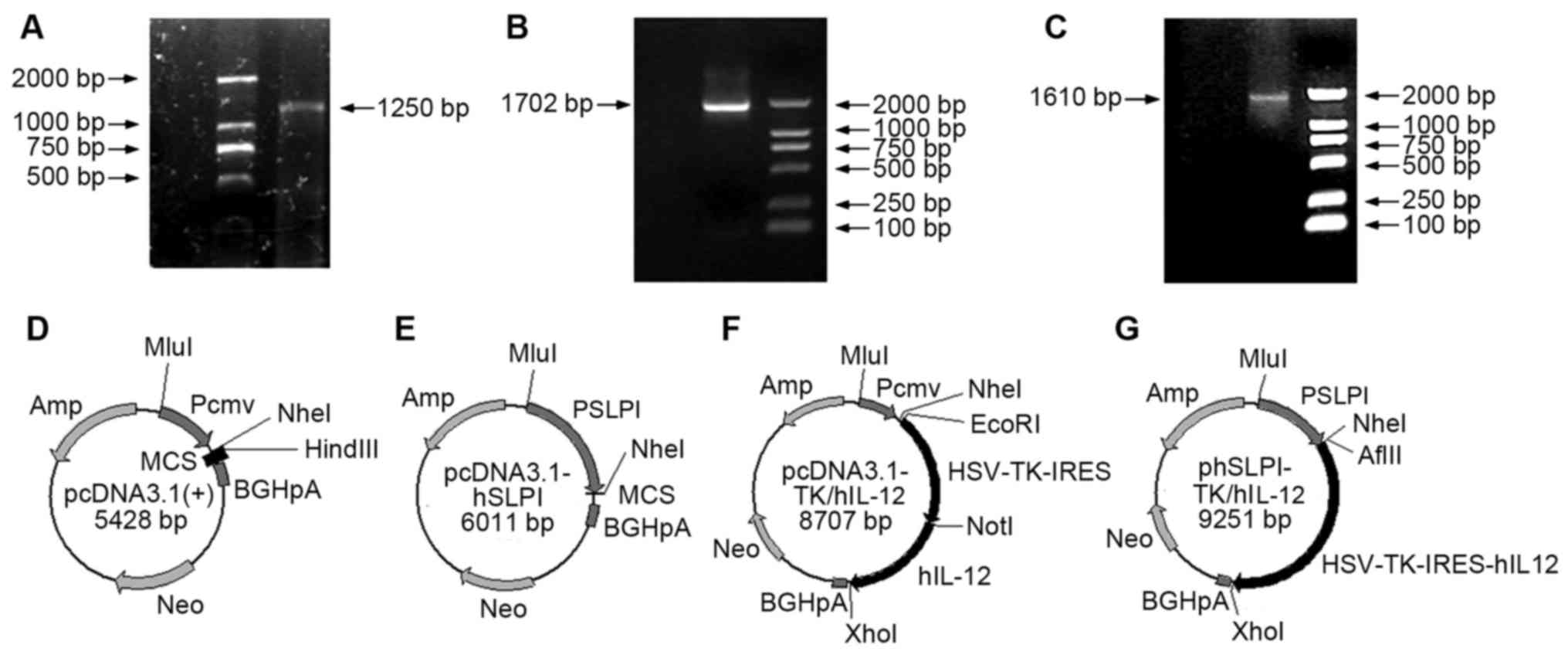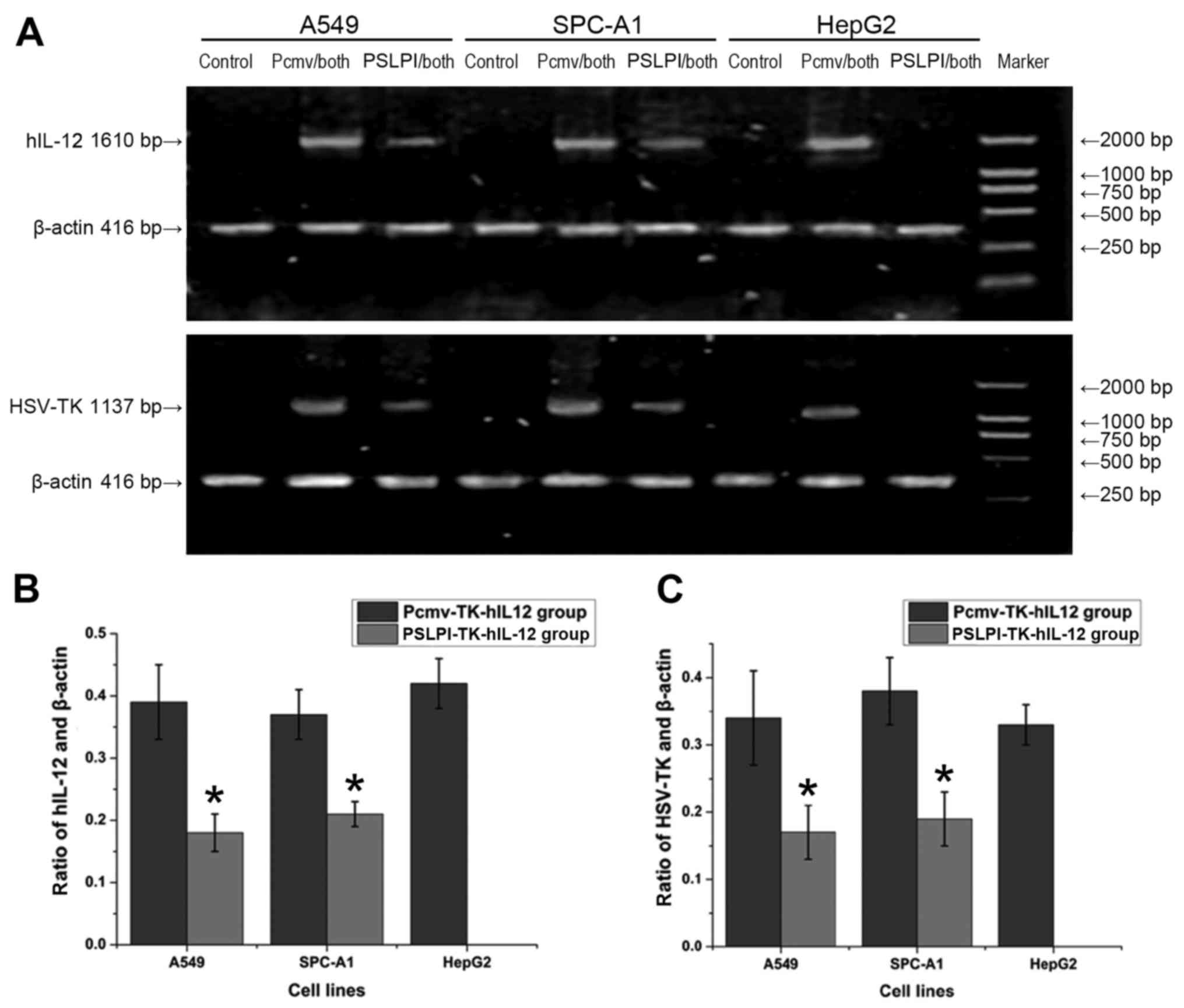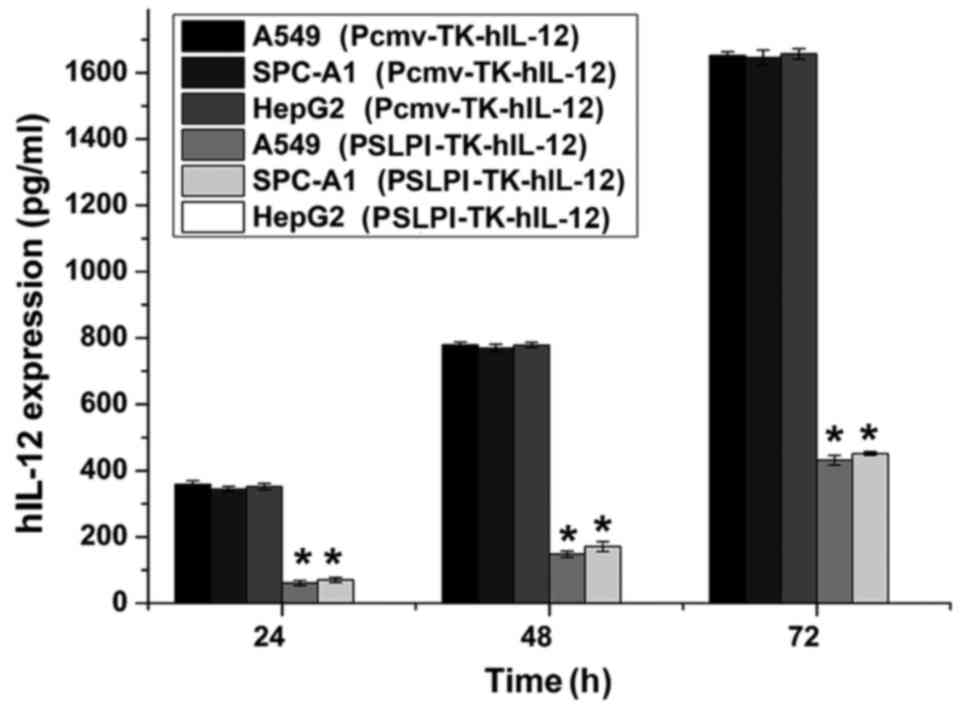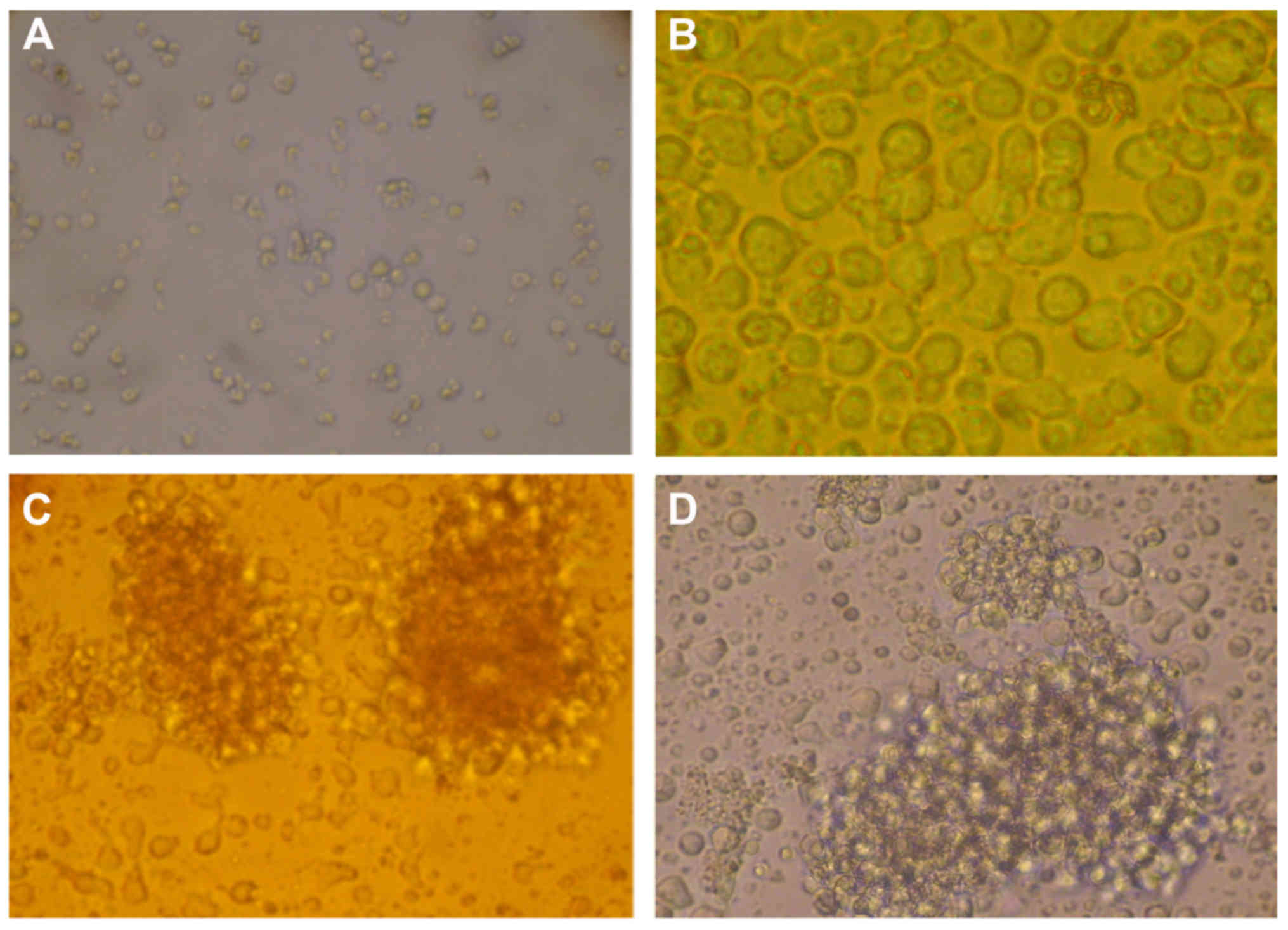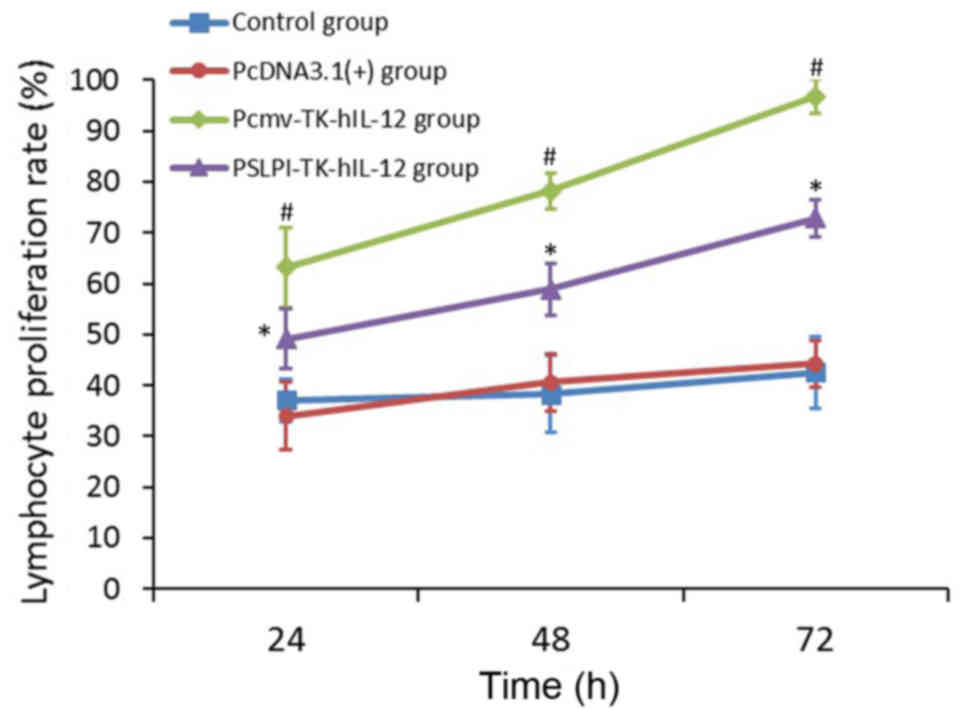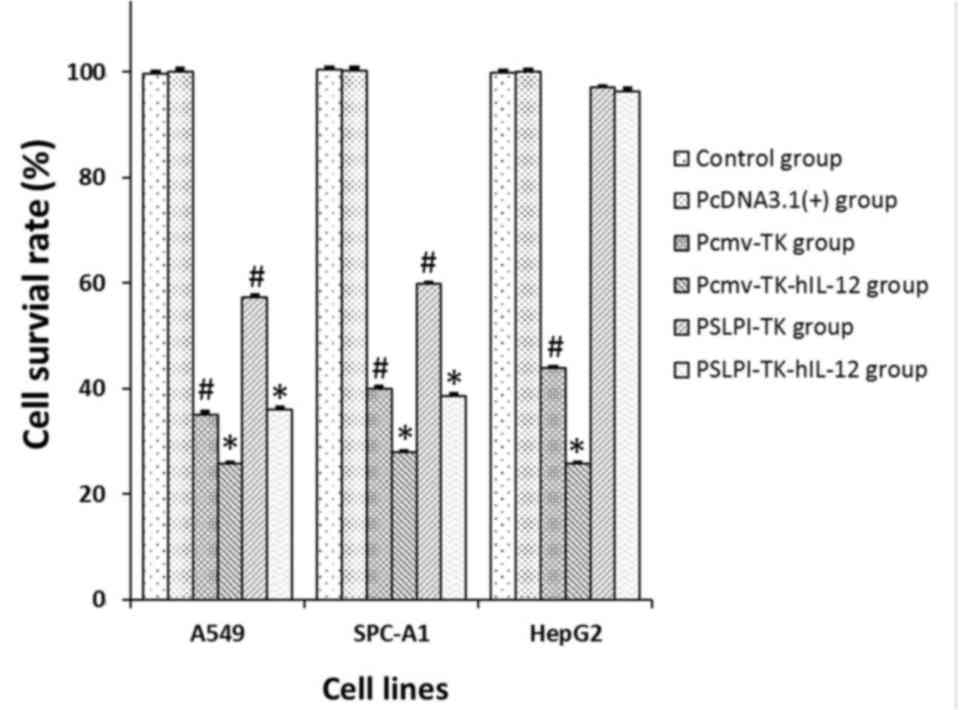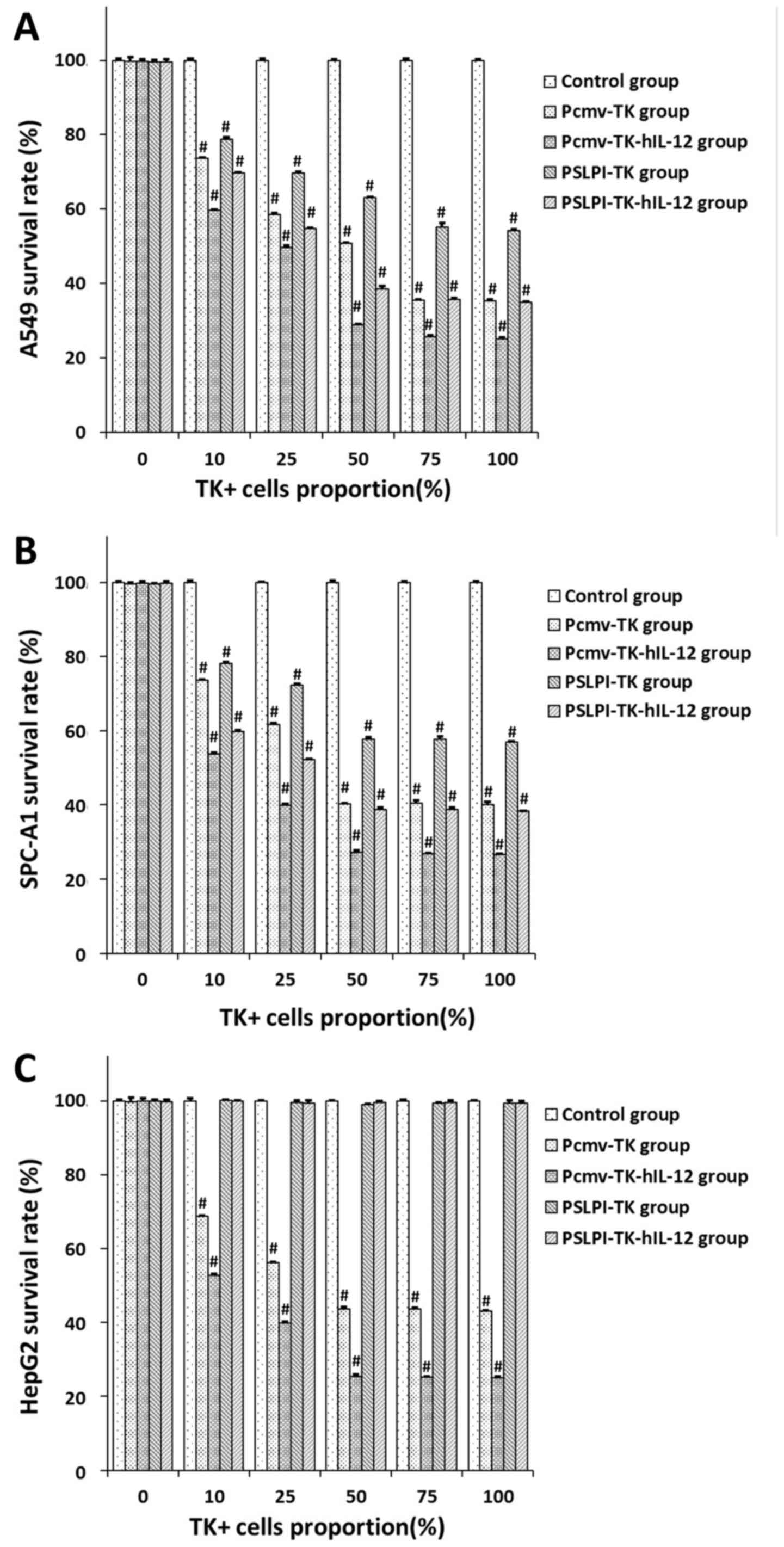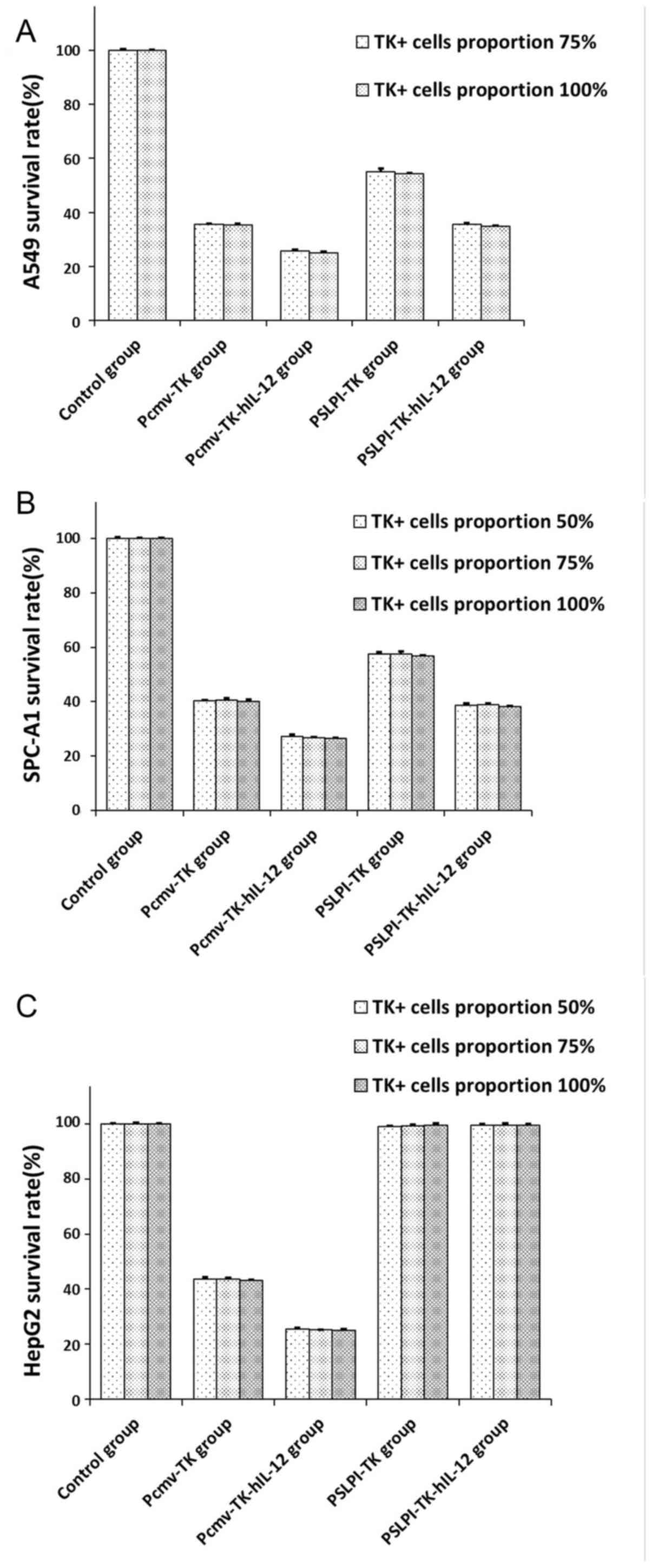Targeted gene therapy of the HSV-TK/hIL-12 fusion gene controlled by the hSLPI gene promoter of human non-small cell lung cancer in vitro
- Authors:
- Published online on: March 1, 2018 https://doi.org/10.3892/ol.2018.8148
- Pages: 6503-6512
Abstract
Introduction
In the last decade, the incidence and mortality of lung cancer have markedly increased globally (1). Of the diagnosed histological types of lung cancer, >80% are non-small cell lung cancer (NSCLC), which is frequently diagnosed at an advanced stage (2). The efficacy of traditional treatment, including surgery, radiotherapy and chemotherapy, is limited, and effective treatments that inhibit tumor recurrence and lower the mortality rate among patients with late-stage lung cancer and distant metastases are still inadequate (3). With recent developments in the molecular etiology and gene therapy of lung cancer, molecular targeted therapies are considered the most promising approach to overcome difficulties with the treatment of lung cancer (4).
The suicide gene therapy caused by herpes simplex virus-thymidine kinase (HSV-TK) has received significant attention due to its direct killing effect and bystander effect (BSE) (5); however, the efficacy of HSV-TK/GCV treatment in treating cancer is limited, due to insufficient gene transfection and the insufficient induction of host immunity (6–8). Previous studies have demonstrated that the combination therapy of HSV-TK and immune genes has an improved response when compared with therapy using the simple HSV-TK gene; additionally, combination therapy has been demonstrated to improve survival time in animals and to promote tumor regression (9,10).
Interleukin (IL)-12 is produced by monocytes, macrophages and B cells. It has multiple physiological and pathological functions and can be used for treating infection, autoimmune disease and tumors (11). A previous study reported that the systemic administration of recombinant IL-2 in combination with HSV-tk gene therapy exhibited an enhanced antitumor effect in a murine bladder cancer model (MBT-2) (12). Also, combination gene therapy with HSV-tk+GCV and IL-12 increased the expression of interferon-γ-dependent Fas and FasL, contributing to tumor cell apoptosis in murine prostate cancer models (RM-1 and RM-9) (13,14); however, the majority of studies regarding the combined gene therapies of HSV-TK and IL-12 have only applied to the mouse (m)IL-12 gene (13,14). Therefore, there are a limited number of studies on the co-operative antitumor effect of the human (h)IL-12 gene (15). The present study further explored the co-operative antitumor effect of the HSV-TK and hIL-12 genes.
The cytomegalovirus (CMV) promoter is frequently used in tumor gene therapy due to its efficient transcription activity in mammalian cells; however, its lack of tumor specificity is a limitation (16,17). In vivo host cells transfected with the CMV promoter can be killed using the metabolites of precursor drugs, which have side effects in normal tissues (16,17); therefore, further studies are required in order to understand how to improve the specificity of the TK gene, thus reducing the side effects.
The human secretory leukocyte protease inhibitor (hSLPI), an 11.7 kDa non-glycosylated, serine protease inhibitor with 107 amino acids (18), is highly active in human cancer cells, including hNSCLC (19), pancreatic (20) and ovarian cancer (21), but not in normal differentiated human cells, including the liver, the endocrine glands and the blood system (22); therefore, hSLPI was selected as a tumor-specific promoter.
In the present study, the hSLPI promoter was cloned, which regulated the HSV-TK/hIL-12 gene-targeted expression in hNSCLC. To the best of our knowledge, the present study was the first to establish a eukaryotic expression vector containing HSV-TK/hIL-12 and hSLPI, and to transfect this into target cells by liposome-mediated gene transfection. The aim of the present study was to investigate the killing effect of the HSV-TK/hIL-12 gene regulated by hSLPI, in order to explore a novel strategy for the molecular targeted therapy of hNSCLC.
Materials and methods
Cell lines and plasmids
Human lung adenocarcinoma cell lines (A549 and SPC-A1) and a hepatoblastoma cell line (HepG2) (23) were obtained from the Jilin Tumor Research Institute (Changchun, China) and the Academy of Military Medical Sciences (Changchun, China), respectively. Plasmid pcDNA3.1(+) was procured from the Central Laboratory of China-Japan Union Hospital of Jilin University (Changchun, China).
Cell culture
A549, SPC-A1 and HepG2 cell lines were cultured in 10-cm plastic culture dishes using Dulbecco's modified Eagle's medium (DMEM; Gibco; Thermo Fisher Scientific, Inc., Waltham, MA, USA), supplemented with 10% Gibco fetal bovine serum (FBS), 100 U/ml penicillin and 100 µg/ml streptomycin. The culture conditions were: 37°C, 5% CO2 and saturated humidity. The medium was changed every two days, and the cells were passaged using trypsin/ethylenediaminetetraacetic acid medium (Gen-View Scientific, Inc., El Monte, CA, USA) at 37°C for 5 min when the confluence was ~100%.
Construction of vectors
The hSLPI promoter gene sequence was amplified by polymerase chain reaction (PCR) using the forward primer, 5′-TTCGACGCGTCTCACTGCAGCCTCAAAC-3′; and the reverse primer, 5′-TTCTAGCTAGCGGTGAAGGCAGGAGTGAC-3′; and the two restriction enzymes MluI and NheI, which were added to each of the primers. After replacing the CMV sequence of pcDNA3.1(+) with hSLPI using the MluI and NheI enzymes, the pcDNA3.1-hSLPI vector was obtained. HSV-TK-IRES and IL-12 sequences were also cloned from the pGT60-hIL-12 vector, provided by Professor Sun Ying from the King's College London (London, UK). The sequences of the primers were as follows: HSV-TK-IRES forward, 5′-AAACCGGAATTCGCCATCATGGCCTCGTAC-3′; and reverse, 5′-TATGCGGCCGCGGTATTATCGTGTTTTTC-3′; and two restriction sites EcoRI and NotI were added to each primer. hIL-12 forward, 5′-AAATATGCGGCCGCTAAGCCACCATGGGTCAC-3′; and reverse, 5′-CCGCTCGAGCGTTAGGAAGCATTCAGATAG-3′; and two restriction sites NotI and Xhol were added to each primer. Vectors containing HSV-TK-IRES and hIL-12 sequences, under the transcription control of the hSLPI promoter, were constructed by connecting the HSV-TK-IRES and hIL-12 sequences to the pcDNA3.1-PSLPI vector, particularly the fusion gene eukaryotic expression vector pcDNA3.1-phSLPI-TK/hIL-12. Vectors containing the fusion gene HSV-TK/hIL-12 regulated by the CMV promoter were also constructed by connecting the HSV-TK-IRES and hIL-12 sequences to the pcDNA3.1(+) vector, particularly pcDNA3.1-CMV-TK/hIL-12. Similarly, by connecting the HSV-TK-IRES to the pcDNA3.1-PSLPI or the pcDNA3.1(+) vectors, a single gene eukaryotic expression vector was produced, either pcDNA3.1-phSLP-TK or pcDNA3.1-CMV-TK.
Liposome-mediated gene transfection
Plasmid pcDNA3.1(+), pcDNA3.1-CMV-TK/hIL-12, pcDNA3.1-CMV-TK, pcDNA3.1-phSLP-TK/hIL-12 and pcDNA3.1-phSLP-TK were extracted using a Endo-Free Plasmid Mini kit (Promega Corporation, Madison, WI, USA). The content and purity of the extracted plasmids were determined using a NanoDrop 2000 (Thermo Fisher Scientific, Inc.). Logarithmic growth phase cells of the A549, SPC-A1 and HepG2 cell lines were seeded into 24-well plates at a density of 5×104 cells/well and cultured for 18–24 h, at 37°C in an atmosphere containing 5% CO2, until the cells reached ~80% confluency.
Following this, cells were transfected using Lipofectamine® 2000, according to the manufacturer's instructions (Invitrogen; Thermo Fisher Scientific, Inc.). Solution A was prepared by diluting 0.4 µg plasmids with 25 µl DMEM without FBS. Solution B was prepared by diluting 1 µl liposomes with 25 µl DMEM without FBS. A mixture of solutions A and B was incubated for 30–45 min at room temperature, and then DMEM without FBS was added to attain a volume of 400 µl. The cells were incubated with the prepared mixture for 5 h; after adding 400 µl DMEM with 20% FBS, the mixture was incubated again. The transfected cells were selected using G418 (Sigma-Aldrich; Merck KGaA, Darmstadt, Germany) at different concentrations (800 mg/l for A549 and SPC-A1; 400 mg/l for HepG2).
The cells were sorted into groups as follows: Control group, cells without transfection; pcDNA3.1(+) group, cells with pcDNA3.1(+); Pcmv-TK-hIL-12 group, cells with pcDNA3.1-CMV-TK/hIL-12; Pcmv-TK group, cells with pcDNA3.1-CMV-TK; PSLPI-TK-hIL-12 group, cells with pcDNA3.1-phSLP-TK/hIL-12; and PSLPI-TK group, cells with pcDNA3.1-phSLP-TK.
HSV-TK/hIL-12 fusion gene expression analysis using reverse transcription (RT)-PCR
Total RNA was extracted from three cell lines in the control, Pcmv-TK-hIL-12 and PSLPI-TK-hIL-12 groups using an RNA Purification kit (Promega Corporation). Total RNA was subjected to cDNA synthesis using a Reverse Transcription System (Promega Corporation). The primers of human β-actin were as follows: Forward, 5′-GAGCTACGAGCTGCCTGACG-3′; and reverse, 5′-CCTAGAAGCATTTGCGGTGG-3′. The primers of HSV-TK and IL-12 are as aforementioned. The RT-PCR performed comprised 35 thermal cycles at 95°C for 5 min, 94°C for 30 sec, 55°C for 45 sec, 72°C for 100 sec and 72°C for 10 min. The PCR product of 5 µl/lane was visualized with ethidium bromide dye on 1% agarose gel and the imaging was observed by JS 680D gel imaging system (Shanghai Peiqing Science and Technology Co., Inc., Shanghai, China). The negative control used was water. The gray value of DNA per lane was analyzed by ImageJ 1.43b (National Institutes of Health, Bethesda, MD, USA).
hIL-12 gene expression levels analysis using an ELISA
The cells in the logarithmic growth phase from the control, pcDNA3.1(+), Pcmv-TK-hIL-12 and PSLPI-TK-hIL-12 groups were seeded in 100-ml culture flasks, with each containing 6×106 cells. The supernatant (0.5 ml) was collected after 24, 48 and 72 h. The IL-12 concentration of the supernatant was determined using the Human IL-12 ELISA kit (cat. no. DRE10282; Solarbio, Beijing, China). Each group underwent three repetitions.
Lymphocyte proliferation assay
The supernatants of the control, pcDNA3.1(+), Pcmv-TK-hIL-12 and PSLPI-TK-hIL-12 group A549 cells, after culture for 72 h, were collected and added to the lymphocytes isolated from healthy human peripheral blood samples obtained at the Second Hospital of Jilin University in May 2014. The present study was conducted with the approval of the Institutional Ethics Committee of The Second Hospital of Jilin University (approval no. 139). Based on the type of supernatant, the lymphocytes were grouped as follows: Control group, pcDNA3.1(+) group, Pcmv-TK-hIL-12 group and PSLPI-TK-hIL-12 group. Each group comprised two subgroups: The experimental well and the control well. Human lymphocytes were plated in a 96-well plate at a density of 1×105 cells/well. The corresponding supernatant (100 µl) and phytohaemagglutinin (PHA, 2 µl, 5 mg/ml; Sigma-Aldrich; Merck KGaA) were added to the cells within the experimental wells to generate a final concentration of 50 µg/ml, and 200 µl of the corresponding supernatant without PHA was added to the cells within the control wells. Each well had a total volume of 200 µl. Following this, lymphocytes were cultured in DMEM containing 10% FBS with 100 U/ml penicillin and 100 µg/ml streptomycin, at 37°C in 5% CO2 humidified atmosphere and an MTT assay was performed after 24, 48 and 72 h. Dimethyl sulfoxide (Sigma-Aldrich; Merck KGaA) was used to dissolve the purple formazan and the wavelength used to measure the formazan was 490 nm. With OD indicating the optical density, the lymphocyte proliferation rate was calculated as follows: Cell proliferation rate (%) = (OD value of experimental well - OD value of control well)/(OD value of control well) × 100%. Each group underwent three repetitions.
Analysis of the direct antitumor effect of the fusion gene using an MTT assay
Three types of cells were divided into six groups, as follows: Control group, pcDNA3.1(+) group, Pcmv-TK-hIL-12 group, Pcmv-TK group, PSLPI-TK-hIL-12 group and PSLPI-TK group. The cells in the logarithmic phase were collected and plated at a density of 5×103 cells/well in a 96-well plate. GCV at a concentration of 10 µg/ml, and lymphocytes at an effector-target ratio of 20:1 were added into the experimental wells, and the DMEM medium (200 µl/well) without GCV or any lymphocytes, was added into the control wells. Each well had a total volume of 200 µl, and each group underwent three repetitions of the assay. The MTT assay was performed after culturing for 72 h at 37°C with an atmosphere containing 5% CO2. The cell survival rate was calculated as follows: Cell survival rate (%) = OD value of experimental well/OD value of control well × 100%.
BSE of fusion gene analysis using an MTT assay
TK+ cells obtained from the Pcmv-TK, PLPI-TK, Pcmv-TK-hIL-12 and PSLPI-TK-hIL-12 groups were cultured together with TK-cells where TK+ cells were in the proportion of 0, 10, 25, 50, 75 and 100% of the total cells. Mixed cells were plated in 96-well plates at a density of 5×103 cells/well, with GCV at a final concentration of 10 µg/ml and lymphocytes at a 20:1 effector-target ratio for the experimental wells, and DMEM medium (200 µl/well) without GCV or lymphocytes for the control wells. Each well had a total volume of 200 µl, and each group had three repetitions. The MTT assay was performed 72 h later. The cell survival rate was calculated as follows: Cell survival rate (%) = OD value of experimental well/OD value of control well × 100%.
Statistical analysis
The SPSS version 13.0 software (SPSS, Inc., Chicago, IL, USA) was used for the statistical analysis. The quantitative data are expressed as the mean ± standard deviation. Student's t-test was used to analyze differences in gene expression and cell survival rate between two groups. A one-way ANOVA followed with least significant difference for post hoc were performed to analyze intergroup differences for hIL-12 gene expression, lymphocyte proliferation rate and cell survival rate. A value of P<0.05 was considered to indicate a statistically significant difference.
Results
The HSV-TK/hIL-12 fusion gene eukaryotic expression vectors regulated by hSLPI are constructed successfully
The hSLPI promoter gene sequence (1,250 bp) was amplified from the genome DNA of human mononuclear cells in the peripheral blood using PCR (Fig. 1A). HSV-TK-IRES (Fig. 1B) and IL-12 (Fig. 1C) sequences were cloned from the pGT60-hIL-12 vector. Replacing the CMV sequence of pcDNA3.1(+) with hSLPI, using MluI and NheI enzymes, enabled the pcDNA3.1-PSLPI vector to be obtained (Fig. 1D and E). After connecting the HSV-TK-IRES and hIL-12 sequences with the pcDNA3.1(+) vector, pcDNA3.1-CMV-TK/hIL-12 was obtained (Fig. 1F). Following connecting the HSV-TK-IRES and hIL-12 sequences with the pcDNA3.1-PSLPI vector, pcDNA3.1-phSLPI-TK/hIL-12 was obtained (Fig. 1G).
HSV-TK/hIL-12 fusion gene regulated by hSLPI promoter is successfully expressed in hNSCLC
HSV-TK/hIL-12 fusion gene expression is demonstrated using RT-PCR
The expression of HSV-TK/hIL-12 mRNA among various groups and three different cell lines was analyzed by RT-PCR. Three electrophoresis bands were observed: β-actin (416 bp), hIL-12 (1,610 bp) and HSV-TK (1,137 bp). The control groups for all three cell lines, and the PSLPI-TK-hIL-12 group for HepG2 cells did not express the hIL-12 or HSV-TK gene. On the contrary, the PSLPI-TK-hIL-12 group for the A549 and SPC-A1 cell lines, and the Pcmv-TK-hIL-12 group for all three cell lines expressed the hIL-12 and HSV-TK genes (Fig. 2A). Evaluation of the OD of the electrophoresis bands indicated no significant differences in the hIL-12 to β-actin ratio in the Pcmv-TK-hIL-12 group among the A549, SPC-A1 and HepG2 cells (0.39±0.06 vs. 0.37±0.04 vs. 0.42±0.04; P>0.05). No significant differences were observed in the PSLPI-TK-hIL-12 group between the A549 and SPC-A1 cells (0.18±0.03 vs. 0.21±0.02; P>0.05) either; however, the ratio in the PSLPI-TK-hIL-12 group was lower than that calculated for the Pcmv-TK-hIL-12 group Between A549 and SPC-A1 cells (P<0.01; Fig. 2B). For the HSV-TK and β-actin ratio, no significant differences were determined between A549, SPC-A1 and HepG2 cells within the Pcmv-TK-hIL-12 group (0.34±0.07 vs. 0.38±0.05 vs. 0.33±0.03; P>0.05). No significant differences in the HSV-TK and β-actin ratio were demonstrated in the PSLPI-TK-hIL-12 group between A549 and SPC-A1 cells (0.17±0.04 vs. 0.19±0.04; P>0.05); however, the ratio was lower in the PSLPI-TK-hIL-12 group than in the Pcmv-TK-hIL-12 group between A549 and SPC-A1 cells (P<0.01; Fig. 2C). The results indicated that the genes regulated by the CMV promoter were expressed in three types of tumor cell lines at the same expression level, without cell specificity. The genes regulated by the hSLPI promoter were expressed in two types of lung cancer cell lines in a targeted manner, the exception being the HepG2 cells.
hIL-12 gene expression in protein level is demonstrated using an ELISA
An ELISA was performed to detect hIL-12 gene expression. The results indicated that all three cell lines infected with Pcmv-TK-hIL-12 expressed hIL-12, and that no significant differences were determined among the A549 [(16.52±0.11 ng)/106/72 h], SPC-A1 [(16.45±0.22 ng)/106/72 h] and HepG2 cells [(16.57±0.14 ng)/106/72 h] (P>0.05). No hIL-12 expression was observed in the PSLPI-TK-hIL-12 group of the HepG2 cells. The expression level of hIL-12 within A549 [(4.32±0.15 ng)/106/72 h] and SPC-A1 cells [(4.52±0.28 ng)/106/72 h] infected with PSLPI-TK-hIL-12 was significantly lower than that in the Pcmv-TK-hIL-12 group (P<0.01). The expression levels of each group increased as the culture time increased (P<0.01; Fig. 3). These results indicated that the gene regulated by the CMV promoter expressed hIL-12 in all three cell lines at the same level, and without cell specificity. The gene regulated by the hSLPI promoter expressed hIL-12 in the two types of lung cancer cell lines, and not in HepG2 cells, with specificity for lung cancer tissue (P<0.01).
hIL-12 promotes lymphocyte proliferation
It was observed via optical microscopy that lymphocytes cultured for 3 days in the control wells of each of the four groups had a round appearance. Conversely, following stimulation with PHA, the lymphocytes increased in volume, their sizes and shapes became irregular and they frequently transformed into lymphoblasts (Fig. 4A-D). The results demonstrated lymphocyte proliferation in all experimental wells, as compared with in the control wells of all of the groups. Compared with the control group, the cell proliferation rate did not change significantly in the pcDNA3.1(+) group; though it increased significantly in the Pcmv-TK-hIL-12 and PSLPI-TK-hIL-12 groups (P<0.01). The increased expression level in the PSLPI-TK-hIL-12 group was still lower than that in the Pcmv-TK-hIL-12 group (P<0.01; Fig. 5). The results indicated that the hIL-12 expressed by the fusion gene eukaryotic expression vectors had notable proliferation activity to the lymphocytes that were stimulated with PHA. The activity increased with the amount of hIL-12 expression and the duration of exposure (P<0.01).
Specific and cooperative killing effect of the HSV-TK/hIL-12 fusion gene regulated by the hSLPI promoter in hNSCLC in vitro
Direct antitumor effect of the HSV-TK/hIL-12 fusion gene
The killing effect of lymphocytes at a 20:1 effector-target ratio combined with GCV at a final concentration of 10 µg/ml was evaluated using an MTT assay after 72 h of culture. For all three cell lines, the cell survival rate in the pcDNA3.1 groups did not change significantly, as compared with in the control groups (P>0.05). In the PSLPI-TK and PSLP-TK-hIL-12 groups of the two lung cancer cell lines, cell survival rate declined significantly, compared with that in the control groups (P<0.01), while no significant difference was noted with the HepG2 cell line (P>0.05). In the Pcmv-TK and Pcmv-TK-hIL-12 groups of the three cell lines, cell survival rate declined significantly, compared with that in the control groups (P<0.01; Fig. 6). These results indicated that TK/GCV gene regulated by the hSLPI promoter had a notable killing effect on the lung cancer cells specifically (P<0.01). Conversely, the CMV promoter had no tissue specificity.
The present study compared the killing effect between single gene and fusion gene treatments. In the CMV control group, the fusion gene therapy had a lower cell survival rate in A549, SPC-A1 and HepG2 cells (25.12, 25.77 and 25.82%, respectively), compared with single gene therapy (35.01, 40.29 and 43.91%, respectively; P<0.01). In the hSLPI control group, the cell survival rate in the fusion gene groups of A549 and SPC-A1 cells (35.99 and 38.54%, respectively) was also lower than that in the single gene groups (57.29 and 59.90%, respectively; P<0.01). These results indicated that the HSV-TK/hIL-12 fusion gene induced cooperative killings.
BSE of the HSV-TK/hIL-12 fusion gene
GCV at a final concentration of 10 µg/ml and lymphocytes at 20:1 effector-target ratio were added into tumor cells, of which TK+ cells accounted for 0, 10, 25, 50, 75 and 100%. An MTT assay was performed 72 h later, and the cell survival rate was calculated. For A549 and SPC-A1 cell lines, the cell survival rate in the Pcmv-TK, Pcmv-TK-hIL-12, PSLPI-TK and PSLP-TK-hIL-12 groups declined significantly from 10% TK+, compared with that in the control groups (P<0.01; Fig. 7A and B). For HepG2 cells, the cell survival rate in the Pcmv-TK and Pcmv-TK-hIL-12 groups declined significantly from 10% TK+, compared with that in the control groups (P<0.01), while no significant difference was noted with the PSLPI-TK and PSLP-TK-hIL-12 groups (P>0.05; Fig. 7C). For the A549 cells at 75% TK+ the survival rate in the control, Pcmv-TK, Pcmv-TK-hIL-12, PSLPI-TK and PSLPI-TK-hIL-12 groups did not change significantly, compared with 100% TK+ (P>0.05; Fig. 8A). For the SPC-A1 cells and HepG2 cells at 50% TK+ the survival rate in the control, Pcmv-TK, Pcmv-TK-hIL-12, PSLPI-TK and PSLPI-TK-hIL-12 groups did not change significantly, compared with 75% TK+ and 100% TK+ (P>0.05; Fig. 8B and C). These results indicated that the HSV-TK/GCV system had a BSE on tumor cells, and that the phSLPI-TK/GCV system had a targeted killing effect on lung cancer cells.
Discussion
In recent years, gene therapy has emerged as a promising strategy for the treatment of cancer (24); however, a number of limitations are associated with its clinical application, particularly the reduced specificity in delivering functional therapeutic genes into tumor cells (25). Therefore, prior studies have been focused on developing targeting strategies (26,27). Tissue-specific promoters represent one of the primary methods of gene therapy (28,29).
hSLPI is produced by cells in the respiratory tract and genital mucosa epithelium, and is highly expressed in hNSCLC (19); by contrast, it has low expression in other normal tissues, particularly in the liver (22). This indicated potential therapeutic inhibitory effects mediated by the expression of tumor necrosis factor (TNF)-associated apoptosis-inducing ligand, TNF-α, death receptor (DR)-4, DR-5 and TNF receptor-I, which lead to the activation of the apoptosis pathway via caspase-2, −8 and −9 (30). Previous studies indicated that SLPI was significantly overexpressed in ovarian cancer samples, compared with in matched normal samples (31). Additionally, studies used the hSLPI promoter to regulate the suicide gene therapy of cervical (32) and ovarian cancer (33) had achieved an antitumor effect. In 2004, Maemondo et al (34) used this promoter in the therapy of hNSCLC (squamous cell carcinoma HS-24 and adenocarcinoma A549 and H358 cells) and achieved a potent antitumor effect in vivo and in vitro. In the present study, the eukaryotic expression vector of HSV-TK/hIL-12 fusion gene regulated by the hSLPI promoter was constructed, specifically expressed in lung cancer cells so as to improve the safety and effectiveness of lung cancer gene therapy. To further investigate the specificity of the hSLPI gene promoter in lung cancer, the HepG2 cell line was selected as the negative control, which had already been constructed in the lab to prove the effectiveness of gene targeting therapy. The HSV-TK/hIL-12 gene expression at the mRNA level was investigated using RT-PCR. The results indicated that genes regulated by the CMV promoter were expressed in three types of tumor cell lines at the same level (P>0.05), without cell specificity. The genes regulated by the hSLPI promoter were expressed in the two types of lung cancer cell lines, and not in HepG2 cells. Coincidentally, an ELISA was preformed to detect the hIL-12 expression, and the results were similar to the RT-PCR findings. The MTT assay also revealed that the HSV-TK/hIL-12 gene regulated by the hSLPI promoter had a notable and specific killing effect on the lung cancer cells (P<0.01). These results demonstrated that the genes regulated by the hSLPI promoter had an effect on lung cancer cells in a targeted manner.
Currently, two commonly used vector systems exist for tumor gene therapy: Viral and non-viral vectors (35). Nanni et al (36) transferred the mIL-12 gene into tumor cells using retroviral vectors. The administration of this product as a vaccine led to tumor regression in 80–90% of the tumor-burdened mice. The output of mIL-12 reached 400-2, 500 pg/l06/24 h. Loskog et al (37) used the adenovirus vector with the mIL-12 gene in bladder cancer therapy and obtained an antineoplastic effect. The production of mIL-12 reached 6–11 ng/ml after the cells were cultured for 48 h in vitro; however, viral vectors have a number of disadvantages (38–42). The major problem is the generation of neutralizing antibodies, which are formed due to immunogenicity and inflammatory toxicity (41). Ring et al (42) determined that when the suicide gene, regulated by the ERBB2 promoter, was transferred into cells using viral vectors, the promoter lost its transcriptional activity and specificity, and its specific antitumor effect was weakened. In comparison, cationic lipids as a non-viral vehicle have several advantages, including low toxicity, no immunogenicity, simple operation, good reproducibility and applicability to mitotic and non-mitotic cells in vivo and in vitro (26). Through continual improvement, the transfection efficiency of liposomes has been increased up to ~90% (43,44); therefore, in the present study, Lipofectamine® 2000 was used, which could provide high transfection efficiency and high levels of transgene expression in a range of mammalian cell types in vitro (45). The present study indicated that the production of the hIL-12 gene, regulated by the CMV promoter, was 16.52±0.11 ng/106/72 h, 16.45±0.22 ng/106/72 h and 16.57±0.14 ng/106/72 h, in A549, SPC-A1 and HepG2 cells, respectively. The data were consistent with those of previous studies.
Since the first application of the TK gene in tumor treatment studies by Moolten in 1986 (46), it had been extensively studied in various human tumor types (9,10,47,48); however, a number of basic and clinical studies indicated that the combination therapy of the HSV-TK gene along with immune-associated genes had a greater success than single TK gene therapy (9–14). Ramesh et al (49) demonstrated that the TK/GCV gene did not inhibit tumor growth effectively in nude mice without immunity, with the transfection rate being 100%. On the contrary, when the transfection rate was 50%, the tumor inhibition rate could reach 100% in mice with normal immunity. The results indicated that the integrity of the host immune system is essential for TK gene therapy. In the present study, by comparing the killing effect of the single gene with the effect of the fusion gene, it was demonstrated that in CMV control groups (A549, SPC-A1 and HepG2) and hSLPI control groups (A549 and SPC-A1), the fusion gene had a lower cell survival rate, compared with the single gene. The results indicated that the HSV-TK/hIL-12 fusion gene induced the cooperative antitumor effect on hNSCLC cell lines in vitro.
Previous studies demonstrated that in the HSV-TK/GCV gene antitumor system not only are the cells transfected with the TK gene killed, but the adjacent non-transfected tumor cells are also (46,50,51). This phenomenon is known as a BSE (52). The BSE can expand the killing effect of the TK/GCV gene significantly (52); therefore, the present study explored the BSE of the TK/GCV system on A549, SPC-A1 and HepG2 cells. The results of the MTT assay indicated that, at 10% TK+, the cell survival rate in the Pcmv-TK/Pcmv-TK-hIL-12 groups (A549, SPC-A1 and HepG2) and the PSLPI-TK/PSLPI-TK-hIL-12 groups (A549 and SPC-A1) declined significantly, compared with the control group (P<0.01). In A549 cells, at 75% TK+, it could achieve the efficiency of the 100% TK+ group. For the SPC-A1 and HepG2 cells, at 50% TK+, it could achieve the efficiency of the 100% TK+ group. These results indicated that the HSV-TK/GCV system had a BSE on tumor cells.
In conclusion, the present study selected the hSLPI promoter as a target for hNSCLC gene therapy. The data indicated that the fusion gene regulated by the hSLPI promoter had targeted expression in hNSCLC, and combined suicide gene therapy with immune gene therapy generated significantly stronger therapeutic antitumor effects, compared with single gene therapy. The present study provided evidence to warrant preclinical studies of this lung cancer treatment, and may present the theoretical basis for a novel therapeutic strategy.
Acknowledgements
This study was supported by the Projects of Health Management Department of Jilin, China (grant no. 20132003), the Department of Science and Technology of Jilin, China (grant nos. 20140311006YY, 20150312022ZG and 20150204028YY), and the Development and Reform Commission of Jilin, China (grant nos. 2013C014-4 and 2014G073).
References
|
Jemal A, Bray F, Center MM, Ferlay J, Ward E and Forman D: Global cancer statistics. CA Cancer J Clin. 61:69–90. 2011. View Article : Google Scholar : PubMed/NCBI | |
|
Itaya T, Yamaoto N, Ando M, Ebisawa M, Nakamura Y, Murakami H, Asai G, Endo M and Takahashi T: Influence of histological type, smoking history and chemotherapy on survival after first-line therapy in patients with advanced non-small cell lung cancer. Cancer Sci. 98:226–230. 2007. View Article : Google Scholar : PubMed/NCBI | |
|
Yang M, Shen H, Qiu C, Ni Y, Wang L, Dong W, Liao Y and Du J: High expression of miR-21 and miR-155 predicts recurrence and unfavourable survival in non-small cell lung cancer. Eur J Cancer. 49:604–615. 2013. View Article : Google Scholar : PubMed/NCBI | |
|
Sun S, Schiller JH, Spinola M and Minna JD: New molecularly targeted therapies for lung cancer. J Clin Invest. 117:2740–2750. 2007. View Article : Google Scholar : PubMed/NCBI | |
|
Zarogoulidis P, Darwiche K, Sakkas A, Yarmus L, Huang H, Li Q, Freitag L, Zarogoulidis K and Malecki M: Suicide gene therapy for cancer-current strategies. J Genet Syndr Gene Ther. 4:168492013.PubMed/NCBI | |
|
Lv SQ, Zhang KB, Zhang EE, Gao FY, Yin CL, Huang CJ, He JQ and Yang H: Antitumor efficiency of the cytosine deaminase/5-fluorocytosine suicide gene therapy system on malignant gliomas: an in vivo study. Med Sci Monit. 15:BR13–BR20. 2009.PubMed/NCBI | |
|
Finocchiaro LM, Riveros MD and Glikin GC: Cytokine-enhanced vaccine and suicide gene therapy as adjuvant treatments of metastatic melanoma in a horse. Vet Rec. 164:278–279. 2009. View Article : Google Scholar : PubMed/NCBI | |
|
Ju DW, Yang Y, Tao Q, Song WG, He L, Chen G, Gu S, Ting CC and Cao X: Interleukin-18 gene transfer increases antitumor effects of suicide gene therapy through efficient induction of antitumor immunity. Gene Ther. 7:1672–1679. 2000. View Article : Google Scholar : PubMed/NCBI | |
|
Drozdzik M, Qian C, Xie X, Peng D, Bilbao R, Mazzolini G and Prieto J: Combined gene therapy with suicide gene and interleukin-12 is more efficient than therapy with one gene alone in a murine model of hepatocellular carcinoma. J Hepatol. 32:279–286. 2000. View Article : Google Scholar : PubMed/NCBI | |
|
Warren P, Song W, Holle E, Holmes L, Wei Y, Li J, Wagner T and Yu X: Combined HSV-TK/GCV and secondary lymphoid tissue chemokine gene therapy inhibits tumor growth and elicits potent antitumor CTL response in tumor-bearing mice. Anticancer Res. 22:599–604. 2002.PubMed/NCBI | |
|
Kerkar SP, Muranski P, Kaiser A, Boni A, Sanchez-Perez L, Yu Z, Palmer DC, Reger RN, Borman ZA, Zhang L, et al: Tumor-specific CD8+ T cells expressing interleukin-12 eradicate established cancers in lymphodepleted hosts. Cancer Res. 70:6725–6234. 2010. View Article : Google Scholar : PubMed/NCBI | |
|
Terao S, Shirakawa T, Goda K, Kamidono S, Fujisawa M and Gotoh A: Recombinant interleukin-2 enhanced the antitumor effect of ADV/RSV-HSV-tk/ACV therapy in a murine bladder cancer model. Anticancer Res. 25:2757–2760. 2005.PubMed/NCBI | |
|
Hall SJ, Canfield SE, Yan Y, Hassen W, Selleck WA and Chen SH: A novel bystander effect involving tumor cell-derived Fas and FasL interactions following Ad.HSV-tk and Ad.mIL12 gene therapies in experimental prostate cancer. Gene Ther. 9:511–517. 2002. View Article : Google Scholar : PubMed/NCBI | |
|
Nasu Y, Bangma CH, Hull GW, Yang G, Wang J, Shimura S, McCurdy MA, Ebara S, Lee HM, Timme TL and Thompson TC: Combination gene therapy with adenoviral vector-mediated HSV-tk+GCV and IL-12 in an orthotopic mouse model for prostate cancer. Prostate Cancer Prostatic Dis. 4:44–55. 2001. View Article : Google Scholar : PubMed/NCBI | |
|
Fogar P, Greco E, Basso D, Habeler W, Navaglia F, Zambon CF, Tormen D, Gallo N, Cecchetto A, Plebani M and Pedrazzoli S: Suicide gene therapy with HSV-TK in pancreatic cancer has no effect in vivo in a mouse model. Eur J Surg Oncol. 29:721–730. 2003. View Article : Google Scholar : PubMed/NCBI | |
|
Okada Y, Okada N, Mizuguchi H, Hayakawa T, Nakagawa S and Mayumi T: Transcriptional targeting of RGD fiber-mutant adenovirus vectors can improve the safety of suicide gene therapy for murine melanoma. Cancer Gene Ther. 12:608–616. 2005. View Article : Google Scholar : PubMed/NCBI | |
|
Schoensiegel F, Paschen A, Sieger S, Eskerski H, Mier W, Rothfels H, Kleinschmidt J, Schadendorf D and Haberkorn U: MIA (melanoma inhibitory activity) promoter mediated tissue-specific suicide gene therapy of malignant melanoma. Cancer Gene Ther. 11:408–418. 2004. View Article : Google Scholar : PubMed/NCBI | |
|
Curvelo JA, Barreto AL, Portela MB, Alviano DS, Holandino C, Souto-Padrón T and Soares RM: Effect of the secretory leucocyte proteinase inhibitor (SLPI) on Candida albicans biologicalprocesses: A therapeutic alternative? Arch Oral Biol. 59:928–937. 2014. View Article : Google Scholar : PubMed/NCBI | |
|
Ameshima S, Ishizaki T, Demura Y, Imamura Y, Miyamori I and Mitsuhashi H: Increased secretory leukoprotease inhibitor in patients with non-small cell lung carcinoma. Cancer. 89:1448–1456. 2000. View Article : Google Scholar : PubMed/NCBI | |
|
Zuo J, Zhang C, Ren C, Pang D, Li Y, Xie X, Tang Z and Jiang X: Secretory leukocyte protease inhibitor is a proliferation and survival factor for pancreatic cancer cells. Clin Transl Oncol. 17:314–321. 2015. View Article : Google Scholar : PubMed/NCBI | |
|
Hough CD, Cho KR, Zonderman AB, Schwartz DR and Morin PJ: Coordinately up-regulated genes in ovarian cancer. Cancer Res. 61:3869–3876. 2001.PubMed/NCBI | |
|
Franken C, Meijer CJ and Dijkman JH: Tissue distribution of antileukoprotease and lysozyme in humans. J Histochem Cytochem. 37:493–498. 1989. View Article : Google Scholar : PubMed/NCBI | |
|
Chen PJ, Kuo MY, Chen ML, Tu SJ, Chiu MN, Wu HL, Hsu HC and Chen DS: Continuous expression and replication of the hepatitis delta virus genome in Hep G2 hepatoblastoma cells transfected with cloned viral DNA. Proc Natl Acad Sci USA. 87:5253–5257. 1990. View Article : Google Scholar : PubMed/NCBI | |
|
Alexandrova R: Experimental strategies in gene therapy of cancer. J Buon. 14:S23–S32. 2009.PubMed/NCBI | |
|
Fukazawa T, Matsuoka J, Yamatsuji T, Maeda Y, Durbin ML and Naomoto Y: Adenovirus-mediated cancer gene therapy and virotherapy (Review). Int J Mol Med. 25:3–10. 2010.PubMed/NCBI | |
|
Das SK, Menezes ME, Bhatia S, Wang XY, Emdad L, Sarkar D and Fisher PB: Gene therapies for cancer: Strategies, challenges and successes. J Cell Physiol. 230:259–271. 2015. View Article : Google Scholar : PubMed/NCBI | |
|
Nettelbeck DM, Jérôme V and Müller R: Gene therapy: Designer promoters for tumour targeting. Trends Genet. 16:174–181. 2000. View Article : Google Scholar : PubMed/NCBI | |
|
Luo XR, Li JS, Niu Y and Miao L: Targeted killing effects of double CD and TK suicide genes controlled by survivin promoter on gastric cancer cell. Mol Biol Rep. 38:1201–1207. 2011. View Article : Google Scholar : PubMed/NCBI | |
|
Teimoori-Toolabi L, Azadmanesh K, Amanzadeh A and Zeinali S: Selective suicide gene therapy of colon cancer exploiting the urokinase plasminogen activator receptor promoter. BioDrugs. 24:131–146. 2010. View Article : Google Scholar : PubMed/NCBI | |
|
Nakamura K, Takamoto N, Hongo A, Kodama J, Abrzua F, Nasu Y, Kumon H and Hiramatsu Y: Secretory leukoprotease inhibitor inhibits cell growth through apoptotic pathway on ovarian cancer. Oncol Rep. 19:1085–1091. 2008.PubMed/NCBI | |
|
Tsukishiro S, Suzumori N, Nishikawa H, Arakawa A and Suzumori K: Use of serum secretory leukocyte protease inhibitor levels in patients to improve specificity of ovarian cancer diagnosis. Gynecol Oncol. 96:516–519. 2005. View Article : Google Scholar : PubMed/NCBI | |
|
Robertson MW III, Wang M, Siegal GP, Rosenfeld M, Ashford RS II, Alvarez RD, Garver RI and Curiel DT: Use of a tissue-specific promoter for targeted expression of the herpes simplex virus thymidine kinase gene in cervical carcinoma cells. Cancer Gene Ther. 5:331–336. 1998.PubMed/NCBI | |
|
Barker SD, Coolidge CJ, Kanerva A, Hakkarainen T, Yamamoto M, Liu B, Rivera AA, Bhoola SM, Barnes MN, Alvarez RD, et al: The secretory leukoprotease inhibitor (SLPI) promoter for ovarian cancer gene therapy. J Gene Med. 5:300–310. 2003. View Article : Google Scholar : PubMed/NCBI | |
|
Maemondo M, Saijo Y, Narumi K, Kikuchi T, Usui K, Tazawa R, Matsumoto K, Nakamura T, Sasaki K, Takahashi M, et al: Gene therapy with secretory leukoprotease inhibitor promoter-controlled replication-competent adenovirus for non-small cell lung cancer. Cancer Res. 64:4611–4620. 2004. View Article : Google Scholar : PubMed/NCBI | |
|
Uchibori R, Okada T, Ito T, Urabe M, Mizukami H, Kume A and Ozawa K: Retroviral vector-producting mesenchymal stem cells for targeted suicide cancer gene therapy. J Gene Med. 11:373–381. 2009. View Article : Google Scholar : PubMed/NCBI | |
|
Nanni P, Rossil L, De Giovanni C, Landuzzi L, Nicoletti G, Stoppacciaro A, Parenza M, Colombo MP and Lollini PL: Interleukin 12 gene therapy of MHC-negative murine melanoma metastases. Cancer Res. 58:1225–1230. 1998.PubMed/NCBI | |
|
Loskog A, Björkland A, Brown MP, Korsgren O, Malmström PU and Tötterman TH: Potent antitumor effects of CD154 transduced tumor cells in experimental bladder cancer. J Urol. 166:1093–1097. 2001. View Article : Google Scholar : PubMed/NCBI | |
|
Brand K, Arnold W, Bartels T, Lieber A, Kay MA, Strauss M and Dörken B: Liver-associated toxicity of the HSV-tk/GCV approach and adenoviral vectors. Cancer Gene Ther. 4:9–16. 1997.PubMed/NCBI | |
|
van der Eb MM, Cramer SJ, Vergouwe Y, Schagen FH, van Krieken JH, van der Eb AJ, Rinkes Borel IH, van de Velde CJ and Hoeben RC: Severe hepatic dysfunction after adenovirus-mediated transfer of the herpes simplex virusthymidine kinase gene and ganciclovir administration. Gene Ther. 5:451–458. 1998. View Article : Google Scholar : PubMed/NCBI | |
|
Larocca C and Schlom J: Viral vector-based therapeutic cancer vaccines. Cancer J. 17:359–371. 2011. View Article : Google Scholar : PubMed/NCBI | |
|
Sterman DH, Recio A, Haas AR, Vachani A, Katz SI, Gillespie CT, Cheng G, Sun J, Moon E, Pereira L, et al: A phase I trial of repeated intrapleural adenoviral-mediated interferon-beta gene transfer for mesothelioma and metastatic pleural effusions. Mol Ther. 18:852–860. 2010. View Article : Google Scholar : PubMed/NCBI | |
|
Ring C, Harris JD, Hurst HC and Lemoine NR: Suicide gene expression induced in tumor cells transduced with recombinant adenoviral, retroviral and plasmid vectors containing the promoter. Gene Ther. 3:1094–1103. 1996.PubMed/NCBI | |
|
Ejeskär K, Fransson S, Zaibak F and Ioannou PA: Method for efficient transfection of in vitro-transcribed mRNA into SK-N-AS and HEK293 cells: Difference in the toxicity of nuclear EGFP compared to cytoplasmic EGFP. Int J Mol Med. 17:1011–1016. 2006.PubMed/NCBI | |
|
Kamaci N, Emnacar T, Karakas N, Arikan G, Tsutsui K and Isik S: Selective silencing of DNA topoisomerase IIβ in human mesenchymal stem cells by siRNAs (small interfering RNAs). Cell Biol Int Rep (2010). 18:e000102011.PubMed/NCBI | |
|
Dalby B, Cates S, Harris A, Ohki EC, Tilkins ML, Price PJ and Ciccarone VC: Advanced transfection with Lipofectamine 2000 reagent: Primary neurons, siRNA, and high-throughput applications. Methods. 33:95–103. 2004. View Article : Google Scholar : PubMed/NCBI | |
|
Moolten FL: Tumor chemosensitivity conferred by inserted herpes thymidine kinase genes: Paradigm for a prospective cancer control strategy. Cancer Res. 46:5276–2581. 1986.PubMed/NCBI | |
|
Ambade AV, Joshi GV and Mulherkar R: Effect of suicide gene therapy in combination with immunotherapy on antitumour immuneresponse & tumour regression in a xenograft mouse model for head & neck squamous cellcarcinoma. Indian J Med Res. 132:415–422. 2010.PubMed/NCBI | |
|
Rodriguez SS, Castro MG, Brown OA, Goya RG and Console GM: Gene therapy for the treatment of pituitary tumors. Expert Rev Endocrinol Metab. 4:359–370. 2009. View Article : Google Scholar : PubMed/NCBI | |
|
Ramesh R, Marrogi AJ, Munshi A, Abboud CN and Freeman SM: In vivo analysis of the ‘bystander effect’: A cytokine cascade. Exp Hamatol. 24:829–838. 1996. | |
|
Wei MX, Bougnoux P, Sacré-Salem B, Peyrat MB, Lhuillery C, Salzmann JL and Klatzmann D: Suicide gene therapy of chemically induced mammary tumor in rat: Efficacy and distant bystander effect. Cancer Res. 58:3529–3532. 1998.PubMed/NCBI | |
|
Kianmanesh AR, Perrin H, Panis Y, Fabre M, Nagy HJ, Houssin D and Klatzmann D: A ‘distant’ bystander effect of suicide gene therapy: Regression of nontransduced tumors together with a distant transduced tumor. Hum Gene Ther. 8:1807–1814. 1997. View Article : Google Scholar : PubMed/NCBI | |
|
van Dillen IJ, Mulder NH, Vaalburg W, de Vries EF and Hospers GA: Influence of the bystander effect on HSV-tk/GCV gene therapy. A review. Curr Gene Ther. 2:307–322. 2002. View Article : Google Scholar : PubMed/NCBI |



